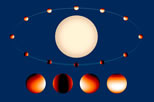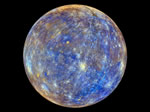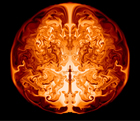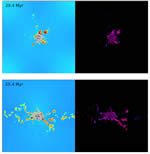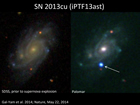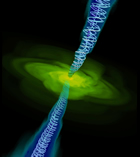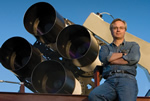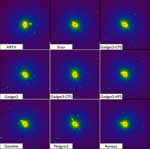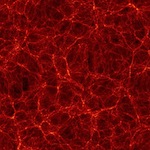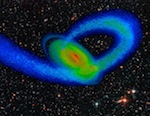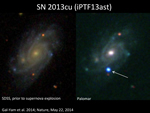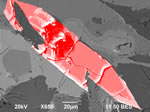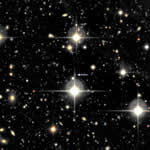AstroShorts are short (several hundred words) stories highlighting current fascinating research in computational astronomy being done by astrophysicists and computational scientists at the nine University of California campuses and three affiliated U.S. Department of Energy laboratories (Lawrence Berkeley National Laboratory, Lawrence Livermore National Laboratory, and Los Alamos National Laboratory)—all consortium members of the University of California High-Performance AstroComputing Center.
AstroShorts are a public service, freely available to astronomical societies, newspapers, science clubs, or other groups wishing to print them and their associated images in a newsletter or publication. All we ask is that credit be given where it is due: Please retain the byline of the writer, and please either use the UC-HiPACC logo or otherwise credit UC-HiPACC as the source, including the UC-HiPACC URL and (if space allows) the explanatory fine print at the end.
Questions? Comments? Feedback? We’d love to hear from you! Please e-mail UC-HiPACC senior writer Trudy E. Bell (tebell@ucsc.edu or t.e.bell@ieee.org ).
December 2014: Wild Weather on WASP-43b
Just in: Weather report for a ‘hot Jupiter’ 260 light-years away: more hellish than Mercury (iron would melt into puddles), because it is more humid—yes, there is water vapor in its atmosphere. And watch out for those howling scorching winds… Read “Wild Weather on WASP-43b,” UC-HiPACC’s latest AstroShort [URL]. Find us on Facebook and follow us on Twitter. Read the AstroShort Wild Weather on WASP-43bHTML | Word doc | PDF (single newsletter page format)
November 2014: Mercury: Snow Globe Dynamo?
How’s this for weird? Mercury’s magnetic field in its northern hemisphere is three times stronger than in its southern hemisphere. A UCLA postdoc ran some numerical models that offer an even weirder explanation: inside Mercury’s molten iron core it is “snowing.” Read the AstroShort Mercury: Snow Globe Dynamo?HTML | Word doc | PDF (single newsletter page format)
October 2014: Without a Trace—Almost
It was a classic case of serendipity. While investigating how supermassive black holes formed in the early universe, UC Santa Cruz postdoc Ke-Jung Chen stumbled on the discovery that some truly monstrous primordial supermassive stars could explode without leaving any black hole or other stellar remnant behind. Read the AstroShort Without a Trace—AlmostHTML | Word doc | PDF (single newsletter page format)
September 2014: Separated at Birth: Finding our Sun’s Long-Lost Siblings?
Any stars born of the same giant molecular cloud always show the same “DNA fingerprint” of chemical abundances of trace elements. But most groups of stars drift apart, eventually even ending up on opposite sides of a galaxy—as likely happened with our Sun. Thus, astronomers have long wondered whether it might be possible to tell if two stars now on opposite sides of the galaxy were born billions of years ago from the same cloud. New simulations explain why, and offer hope: might it be possible to find our own Sun’s long-lost siblings? Read the AstroShort Separated at Birth: Finding our Sun’s Long-Lost Siblings?
HTML | Word doc | PDF (single newsletter page format)
August 2014: ‘Smoking Gun’ for Stellar Explosion Mystery
Whodunit? A brilliant flash of ultraviolet light from a supernova in a distant galaxy in the constellation Boötes solved an enduring mystery about the origins of massive exploding stars called Type IIb core-collapse supernovae. “This is the smoking gun!” exulted Peter Nugent, head of the Computational Cosmology Center at Lawrence Berkeley National Laboratory. Read the AstroShort ‘Smoking Gun’ for Stellar Explosion Mystery
HTML | Word doc | PDF (single newsletter page format)
July 2014: Magnetically Levitating Black Holes
Loud and twisted: some supermassive black holes at the centers of galaxies have twisted magnetic fields so powerful they counteract the colossal pull of their gravity—allowing clouds of accreting gas or other objects literally to levitate temporarily in place above the black hole instead of plunging into the maw. That’s the conclusion of one UC Berkeley researcher and three coauthors after comparing their computational model to empirical measurements of not just one or two, but of 76 supermassive black holes in loud radio galaxies and blazars. The new findings may mean that theorists must re-evaluate their understanding of how supermassive black holes behave. Read the AstroShort “Magnetically Levitating Black Holes”
HTML | Word doc | PDF (single newsletter page format)
May 2014: Drying Out the Moon?
Moon rocks brought back by the Apollo astronauts revealed that the lunar mineral apatite is everywhere, from the ancient lunar highlands to the young lunar maria (lava seas). Much of it is rich in hydrogen. Taking hydrogen as a proxy for water, the evidence suggested that the material from which the Moon formed might have been as wet as that which formed Earth. Apatite became widely adopted as a yardstick for measuring hydrogen—and thus water—in the Moon. But a new computational model of how apatite crystalized from lunar magmas, devised by Jeremy W. Boyce at UC Los Angeles and four coauthors, now reveals that apatite, the mineral on which scientists have long relied, “cannot be trusted.” Read the AstroShort “Drying Out the Moon?”
HTML | Word doc | PDF (single newsletter page format)
April 2014: Not-So-Rare Earths
If the stars observed by NASA’s Kepler spacecraft are statistically representative of those in our own solar neighborhood of the Milky Way galaxy, then “Earth-size planets are common around nearby Sun-like stars,” conclude Erik A. Petigura and Geoffrey W. Marcy from the University of California, Berkeley and Andrew W. Howard from the University of Hawaii. Indeed, their new statistical analysis of Kepler data—performed with the help of the Carver supercomputer—suggests that the nearest Earth-size planet orbiting in the habitable zone around a Sun-like star may be “less than 12 light-years from Earth” and its host star might even “be seen by the unaided eye.” Read the Astroshort “Not-So-Rare Earths”.
HTML | Word doc | PDF (single newsletter page format)
March 2014: Discovered: Stellar Dinosaurs!
“We had no idea what these things were,” recounted D. Andrew Howell, staff scientist at Las Cumbres Observatory Global Telescope Network and adjunct assistant professor at UC Santa Barbara. Two objects caught by the detectors of the Supernova Legacy Survey looked like supernovae—stars exploding in cataclysmic stellar suicide—but did not act like familiar supernovae. The finding launched Howell along with Daniel Kasen, computational astrophysicist at UC Berkeley, and 16 colleagues into detective sleuthing that led to the discovery of …. Read the Astroshort “Discovered: Stellar Dinosaurs!”.
HTML | Word doc | PDF (single newsletter page format)
January 2014: A Black Hole is Born—and Caught in the Act!
Astrophysicists had unusual ringside seats to the birth of a black hole in an inconspicuous galaxy, watching across all wavelengths from initial gamma ray burst and optical flash through fading afterglow. Read the AstroShort “A Black Hole is Born—and Caught in the Act!”.
HTML | Word doc | PDF (single newsletter page format)
December 2013: AGORA—Seeing the Invisible Elephant
Why should astrophysicists believe computational simulations about the origins of the universe and evolution of galaxies? After all, results from different codes differ. Now, a major international effort Project AGORA is systematically comparing major computational codes to tease out the real astrophysics…. Read Astroshort.
HTML | Word doc | PDF (single newsletter page format)
November 2013: HAWC-Eye on the Sky
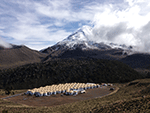
A telescope made of water—HAWC, high in Mexico’s mountains—has begun monitoring the heavens to capture the Universe’s most violent events. Read Astroshort.
HTML | Word doc | PDF (single newsletter page format)
September 2013: Measuring Olbers’s Paradox

Streaming through deep space today in some form is almost all the light that all galaxies have ever radiated. Capturing those precious ancient photons of extragalactic background light allows astronomers to deduce details about the grand story of cosmic origin. Read Astroshort.
HTML | Word doc | PDF (single newsletter page format)
May 2013: Planck: Revising the Universe

The Universe is about 100 million years older than previously estimated and is expanding slightly more slowly; it also has slightly more dark matter and a bit less dark energy than previously suspected. Read Astroshort.
HTML | Word doc | PDF (single newsletter page format)
March 2013: Planets Amidst the Noise

Tau Ceti’s five Earth-sized planets were not supposed to be there. They revealed themselves when Steven S. Vogt, astrophysics professor at UC Santa Cruz, and his collaborators were testing a new noise-analysis method on spectrometer data to calibrate a new computational technique. Read Astroshort.
HTML | Word doc | PDF (single newsletter page format)
February 2013: Milky Way: Cosmic Cannibal!

In June, the supermassive black hole Sgr A* at the center of the Milky Way is about to capture and gobble a gas cloud. Astronomers are eagerly waiting to watch the feeding frenzy—and see how well its details were predicted by computational simulations. Read Astroshort.
HTML | Word doc | PDF (single newsletter page format)
December 2012: Planet Formation: More Questions Than Answers

Now that NASA's Kepler spacecraft and various ground-based observations have confirmed 847 planets as existing around 642 stars within several hundred light-years of our Sun, how has their discovery altered astrophysicists' theories about how planetary systems form around stars? Read Astroshort.
HTML| Word doc | PDF (single newsletter page format)
October 2012: Disk Galaxies: Settling for Beauty with Age
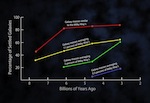
Spectroscopic observations of distant galaxies taken with the 10-meter telescopes at the W. M. Keck Observatory on Hawaii, when combined with images from the Hubble Space Telescope plus supercomputer simulations to interpret the observations, reveal a beautiful surprise about disk galaxies. Read Astroshort.
HTML | Word doc | PDF (single newsletter page format)
March 2012: Simulating the Universe

Supercomputers and powerful computational techniques allow astrophysicists to build large simulations—computational working models—of many astronomical processes. The most accurate cosmological simulation yet made of the evolution of the large-scale structure of the early universe is named Bolshoi. Read Astroshort.
HTML | Word doc | PDF (single newsletter page format)
February 2012: Catching stars that go BANG!

Want to watch a star explode? Two automated telescopes and two supercomputer centers are scanning tens of thousands of galaxies every night—and catching stars right in the very act of starting to blow themselves to atoms, some becoming so brilliant that for a few days they rival the brightness of their home galaxies.
HTML | Word doc | PDF (single newsletter page format)
January 2012: How the Milky Way became spiral?

A dwarf galaxy that has collided with the Milky Way twice—and is now on collision course for a third impact—may have triggered the formation of our home galaxy’s beautiful spiral arms.
HTML | Word doc | PDF (single newsletter page format)
